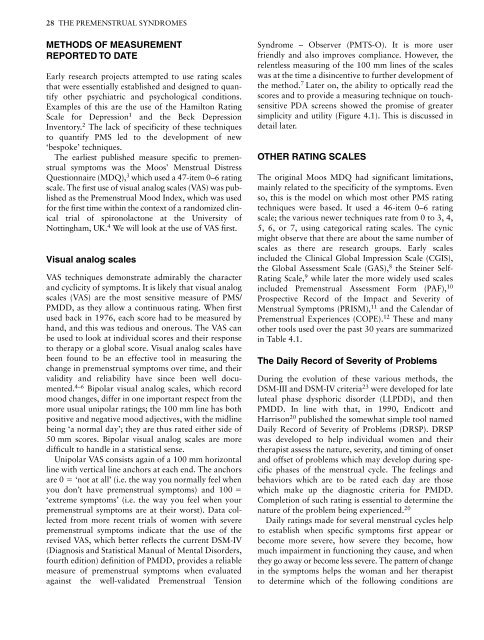Premenstrual Syndromes : PMS and PMDD - Rutuja :: The site ...
Premenstrual Syndromes : PMS and PMDD - Rutuja :: The site ...
Premenstrual Syndromes : PMS and PMDD - Rutuja :: The site ...
Create successful ePaper yourself
Turn your PDF publications into a flip-book with our unique Google optimized e-Paper software.
28 THE PREMENSTRUAL SYNDROMES<br />
METHODS OF MEASUREMENT<br />
REPORTED TO DATE<br />
Early research projects attempted to use rating scales<br />
that were essentially established <strong>and</strong> designed to quantify<br />
other psychiatric <strong>and</strong> psychological conditions.<br />
Examples of this are the use of the Hamilton Rating<br />
Scale for Depression 1 <strong>and</strong> the Beck Depression<br />
Inventory. 2 <strong>The</strong> lack of specificity of these techniques<br />
to quantify <strong>PMS</strong> led to the development of new<br />
‘bespoke’ techniques.<br />
<strong>The</strong> earliest published measure specific to premenstrual<br />
symptoms was the Moos’ Menstrual Distress<br />
Questionnaire (MDQ), 3 which used a 47-item 0–6 rating<br />
scale. <strong>The</strong> first use of visual analog scales (VAS) was published<br />
as the <strong>Premenstrual</strong> Mood Index, which was used<br />
for the first time within the context of a r<strong>and</strong>omized clinical<br />
trial of spironolactone at the University of<br />
Nottingham, UK. 4 We will look at the use of VAS first.<br />
Visual analog scales<br />
VAS techniques demonstrate admirably the character<br />
<strong>and</strong> cyclicity of symptoms. It is likely that visual analog<br />
scales (VAS) are the most sensitive measure of <strong>PMS</strong>/<br />
<strong>PMDD</strong>, as they allow a continuous rating. When first<br />
used back in 1976, each score had to be measured by<br />
h<strong>and</strong>, <strong>and</strong> this was tedious <strong>and</strong> onerous. <strong>The</strong> VAS can<br />
be used to look at individual scores <strong>and</strong> their response<br />
to therapy or a global score. Visual analog scales have<br />
been found to be an effective tool in measuring the<br />
change in premenstrual symptoms over time, <strong>and</strong> their<br />
validity <strong>and</strong> reliability have since been well documented.<br />
4–6 Bipolar visual analog scales, which record<br />
mood changes, differ in one important respect from the<br />
more usual unipolar ratings; the 100 mm line has both<br />
positive <strong>and</strong> negative mood adjectives, with the midline<br />
being ‘a normal day’; they are thus rated either side of<br />
50 mm scores. Bipolar visual analog scales are more<br />
difficult to h<strong>and</strong>le in a statistical sense.<br />
Unipolar VAS consists again of a 100 mm horizontal<br />
line with vertical line anchors at each end. <strong>The</strong> anchors<br />
are 0 � ‘not at all’ (i.e. the way you normally feel when<br />
you don’t have premenstrual symptoms) <strong>and</strong> 100 �<br />
‘extreme symptoms’ (i.e. the way you feel when your<br />
premenstrual symptoms are at their worst). Data collected<br />
from more recent trials of women with severe<br />
premenstrual symptoms indicate that the use of the<br />
revised VAS, which better reflects the current DSM-IV<br />
(Diagnosis <strong>and</strong> Statistical Manual of Mental Disorders,<br />
fourth edition) definition of <strong>PMDD</strong>, provides a reliable<br />
measure of premenstrual symptoms when evaluated<br />
against the well-validated <strong>Premenstrual</strong> Tension<br />
Syndrome – Observer (PMTS-O). It is more user<br />
friendly <strong>and</strong> also improves compliance. However, the<br />
relentless measuring of the 100 mm lines of the scales<br />
was at the time a disincentive to further development of<br />
the method. 7 Later on, the ability to optically read the<br />
scores <strong>and</strong> to provide a measuring technique on touchsensitive<br />
PDA screens showed the promise of greater<br />
simplicity <strong>and</strong> utility (Figure 4.1). This is discussed in<br />
detail later.<br />
OTHER RATING SCALES<br />
<strong>The</strong> original Moos MDQ had significant limitations,<br />
mainly related to the specificity of the symptoms. Even<br />
so, this is the model on which most other <strong>PMS</strong> rating<br />
techniques were based. It used a 46-item 0–6 rating<br />
scale; the various newer techniques rate from 0 to 3, 4,<br />
5, 6, or 7, using categorical rating scales. <strong>The</strong> cynic<br />
might observe that there are about the same number of<br />
scales as there are research groups. Early scales<br />
included the Clinical Global Impression Scale (CGIS),<br />
the Global Assessment Scale (GAS), 8 the Steiner Self-<br />
Rating Scale, 9 while later the more widely used scales<br />
included <strong>Premenstrual</strong> Assessment Form (PAF), 10<br />
Prospective Record of the Impact <strong>and</strong> Severity of<br />
Menstrual Symptoms (PRISM), 11 <strong>and</strong> the Calendar of<br />
<strong>Premenstrual</strong> Experiences (COPE). 12 <strong>The</strong>se <strong>and</strong> many<br />
other tools used over the past 30 years are summarized<br />
in Table 4.1.<br />
<strong>The</strong> Daily Record of Severity of Problems<br />
During the evolution of these various methods, the<br />
DSM-III <strong>and</strong> DSM-IV criteria 23 were developed for late<br />
luteal phase dysphoric disorder (LLPDD), <strong>and</strong> then<br />
<strong>PMDD</strong>. In line with that, in 1990, Endicott <strong>and</strong><br />
Harrison 20 published the somewhat simple tool named<br />
Daily Record of Severity of Problems (DRSP). DRSP<br />
was developed to help individual women <strong>and</strong> their<br />
therapist assess the nature, severity, <strong>and</strong> timing of onset<br />
<strong>and</strong> offset of problems which may develop during specific<br />
phases of the menstrual cycle. <strong>The</strong> feelings <strong>and</strong><br />
behaviors which are to be rated each day are those<br />
which make up the diagnostic criteria for <strong>PMDD</strong>.<br />
Completion of such rating is essential to determine the<br />
nature of the problem being experienced. 20<br />
Daily ratings made for several menstrual cycles help<br />
to establish when specific symptoms first appear or<br />
become more severe, how severe they become, how<br />
much impairment in functioning they cause, <strong>and</strong> when<br />
they go away or become less severe. <strong>The</strong> pattern of change<br />
in the symptoms helps the woman <strong>and</strong> her therapist<br />
to determine which of the following conditions are


